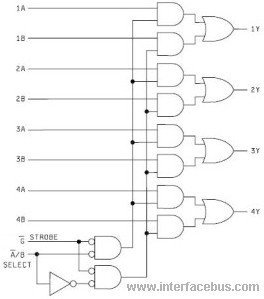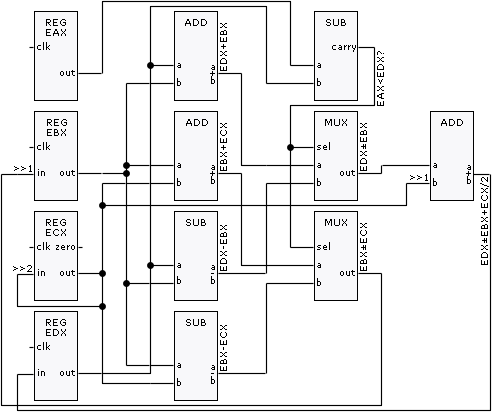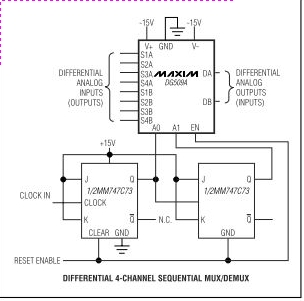
IC Multiplexers

There is a lack of clarity regarding the difference between a data selector and a multiplexer. The designs previously engaged in ceased utilizing small-scale integrated circuits in the early 1990s, as the physical aspect transitioned to general-purpose programmable array logic (PALs) and complex programmable logic devices (CPLDs). Subsequently, any new designs were developed in significantly larger field-programmable gate arrays (FPGAs), rendering the addition of individual integrated circuits for minor functions unnecessary, as these tasks could be efficiently managed within an FPGA. However, the design or the volume of products shipped would need to justify the cost of an FPGA, which can be several hundreds of dollars, compared to a low-cost decoder priced at around 20 cents.
A data selector, often referred to as a multiplexer (MUX), is a combinational circuit that selects one of several input signals and forwards the selected input into a single line. The primary function of a multiplexer is to route multiple signals through a single output line, thereby conserving the number of pathways required for signal transmission. A multiplexer typically operates using control lines that determine which input to select. For instance, a 4-to-1 multiplexer has four input lines and two control lines, allowing it to select one of the four inputs based on the binary value represented by the control lines.
In contrast, the term "data selector" is sometimes used interchangeably with multiplexer; however, it can also refer to circuits specifically designed to route data based on certain conditions or criteria, often with added functionalities such as enabling or disabling outputs. This differentiation may arise from the context of use, where data selectors are implemented in specific applications requiring additional logic beyond simple signal routing.
The evolution of circuit design from small-scale integrated circuits to larger FPGAs reflects a significant shift in the approach to electronic design. FPGAs provide a versatile platform that can be programmed to perform a wide range of functions, including those that would traditionally require multiple discrete ICs. The ability to implement complex logic functions within a single FPGA not only reduces the physical space required for circuit design but also enhances the performance and flexibility of electronic systems.
The cost consideration is pivotal in selecting between using an FPGA or discrete components like decoders. While FPGAs offer substantial capabilities, their higher cost must be justified by the design requirements and the expected production volume. For low-volume applications or simple functions, the use of a low-cost decoder may be more economically viable. Understanding the trade-offs between component costs, design complexity, and performance requirements is essential in making informed decisions in electronic circuit design.I`m not all that clear of the difference between a data selector and a multiplexer. Although the designs I`ve been involved in stopped using small scale ICs in the early 1990`s, as the physical side of the work moved into general purpose PALs and MACHs. Following that, any new designs were generated in much larger FPGAs, so there was little need to add an individual IC to perform a minor function, easily handled in an FPGA. Of course the design, or the number of product shipped would need to support the cost of an FPGA costing hundreds as opposed to a 20 cent decoder. 🔗 External reference
A data selector, often referred to as a multiplexer (MUX), is a combinational circuit that selects one of several input signals and forwards the selected input into a single line. The primary function of a multiplexer is to route multiple signals through a single output line, thereby conserving the number of pathways required for signal transmission. A multiplexer typically operates using control lines that determine which input to select. For instance, a 4-to-1 multiplexer has four input lines and two control lines, allowing it to select one of the four inputs based on the binary value represented by the control lines.
In contrast, the term "data selector" is sometimes used interchangeably with multiplexer; however, it can also refer to circuits specifically designed to route data based on certain conditions or criteria, often with added functionalities such as enabling or disabling outputs. This differentiation may arise from the context of use, where data selectors are implemented in specific applications requiring additional logic beyond simple signal routing.
The evolution of circuit design from small-scale integrated circuits to larger FPGAs reflects a significant shift in the approach to electronic design. FPGAs provide a versatile platform that can be programmed to perform a wide range of functions, including those that would traditionally require multiple discrete ICs. The ability to implement complex logic functions within a single FPGA not only reduces the physical space required for circuit design but also enhances the performance and flexibility of electronic systems.
The cost consideration is pivotal in selecting between using an FPGA or discrete components like decoders. While FPGAs offer substantial capabilities, their higher cost must be justified by the design requirements and the expected production volume. For low-volume applications or simple functions, the use of a low-cost decoder may be more economically viable. Understanding the trade-offs between component costs, design complexity, and performance requirements is essential in making informed decisions in electronic circuit design.I`m not all that clear of the difference between a data selector and a multiplexer. Although the designs I`ve been involved in stopped using small scale ICs in the early 1990`s, as the physical side of the work moved into general purpose PALs and MACHs. Following that, any new designs were generated in much larger FPGAs, so there was little need to add an individual IC to perform a minor function, easily handled in an FPGA. Of course the design, or the number of product shipped would need to support the cost of an FPGA costing hundreds as opposed to a 20 cent decoder. 🔗 External reference
Warning: include(partials/cookie-banner.php): Failed to open stream: Permission denied in /var/www/html/nextgr/view-circuit.php on line 713
Warning: include(): Failed opening 'partials/cookie-banner.php' for inclusion (include_path='.:/usr/share/php') in /var/www/html/nextgr/view-circuit.php on line 713



